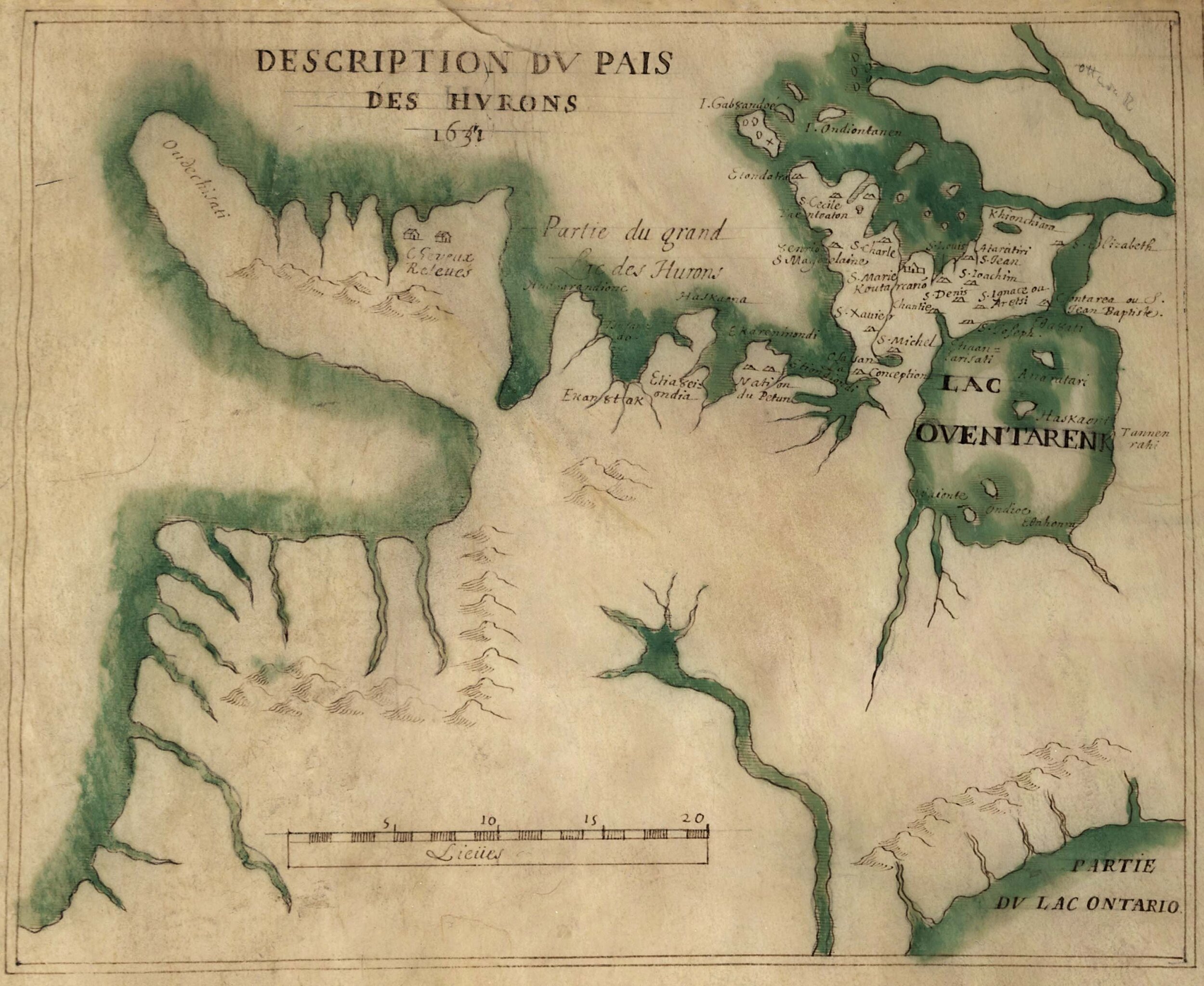1 July 2021
Ontario is the name of one of the Great Lakes of North America and of the most populous province of Canada. The name is of Iroquoian origin, but which language and, therefore, its original meaning are uncertain. What is clear is that it was originally the name of the lake and became a name for the territory in English usage.
Ontario is a French spelling of the name. Some sources give the origin as the Kanienʼkéha (Mohawk) õtaríyo, or õtar (lake, river, waterway) + iyo (beautiful). Other sources give the origin as the Huron ontare (lake). And yet others say it means rocks near the water, referring to the Niagara Escarpment, through which the Niagara River flows, producing the spectacular Niagara Falls on its way into the lake’s southern end.
The French name appears on a map bearing the date 1631 (pictured), although the “3” has been overwritten with a “5,” giving a date of 1651. The current best estimate is that the map was drawn between 1639–48, with minor revisions after 1650, hence the changed date. A date from early in this span would make this map the earliest known use of the French name. The next candidate for earliest known use would be in the Jesuit Relations of 1641–42, which recounts the travels of missionaries to the region:
Du premier bourg de la Nation Neutre, que I'on rencontre y arriuant d'icy, continuant de cheminer au Midy ou Sudest, il y a enuiron quatre iournées de chemin iusques à l’emboucheure de la Riuiere si celebre de cette Nation, dans l'Ontario ou lac de S. Louys. Au deçà de cette Riuiere, & non au delà, comme le marque quelque Charte, sont la plus part des bourgs de la Nation Neutre. Il y en a trois ou quatre au delà, rangez d'Orient à I'Occident, vers la Nation du Chat, ou Erieehronõs.
(From the first village of the Neutral Nation which one finds on arriving there from this place, and continuing to travel South or Southeast, it is about four days journey to the entrance of the very famous River of that Nation, into the [Lake] Ontario or lake of St. Louis. On this side of that River—and not beyond it, as a certain map indicates—are the greater part of the villages of the Neutral Nation. There are three or four beyond, ranging from East to West, towards the Nation of the Cat, or Eriehurons.)
Ontario is used as the name of the lake in English by 1698, when it appears in a translation of an account of the travels through the Great Lakes region of René-Robert Cavelier, Sieur de La Salle:
Every thing being ready for our departure, we set sail from Rochel, July 14. 1678. to the number of 30 Men, amongst whom were Pilots, Carpenters, Smiths and other useful Artists, and arrived at Quebec upon the 15th of September following; we remained there some days, after which having taken our Leave of Count Frontenac Governor-General of Canada, we sailed up the River St. Laurence to Fort Frontenac, where we landed.
That Fort lyes within 120 Leagues from Quebec, about the 44th Degree of Latitude, on the Mouth of a Lake called likewise Frontenac or Ontario, which is near 300 Leagues about, and has a communication with four other Lakes, much of the same extent.
The lake’s name was transferred to a territory in 1792, when the first county of Ontario was created. The province was officially named in 1867.
Sources:
An Account of Monsieur de la Salle’s Last Expedition and Discoveries in North America. London: J. Tonson, 1698, 2–3. Early English Books Online (EEBO).
Everett-Heath, John. Concise Oxford Dictionary of World Place Names, sixth ed. Oxford: Oxford UP, 2020. Oxfordreference.com.
The Jesuit Relations and Allied Documents: Travels and Explorations of the Jesuit Missionaries in New France, 1610–1791, Quebec and Hurons, 1641–42, vol. 21. Reuben Gold Thwaites, ed. Cleveland: Burrows Brothers, 1898, 188–91. HathiTrust Digital Archive. https://www.hathitrust.org/
Oxford English Dictionary, third edition, December 2020, s.v. Ontarian, n. and adj.
Rayburn, Alan. Oxford Dictionary of Canadian Place Names. Don Mills, Ontario: Oxford UP Canada, 1999.
Image credit: Unknown cartographer, 1631. Library of Congress. Public domain image.

